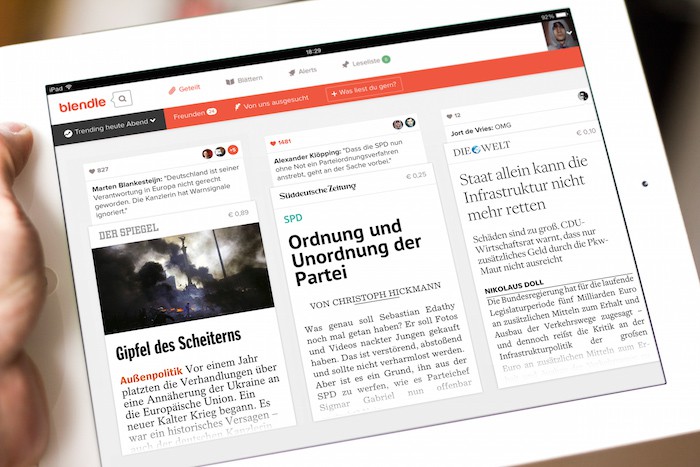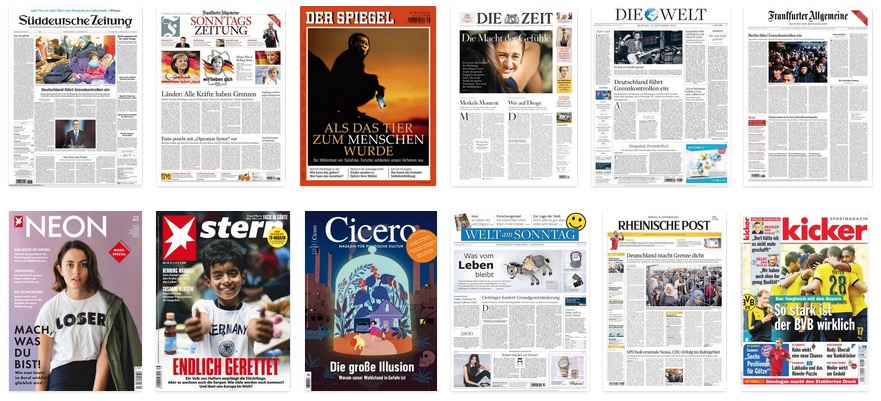
More than a year after debuting in the Netherlands, Blendle, a micropayment platform, is expanding into Germany today, with more than 100 German and English-language publications signing on as partners.
Blendle collects stories from publishers and lets users then pay for individual articles, no matter where it was originally published. Each publisher sets its own prices and then takes 70 percent of the revenue, with Blendle taking the rest. In the Netherlands, the average article goes for 20 cents, and two-thirds of its users are under 35, the company says.
The site launched in April 2014 in its home country, and last fall The New York Times Co. and Axel Springer invested €3 million in the company. Blendle’s expansion into Germany is its first foray beyond Dutch borders. “People want to see if this was a Dutch accident or if it is an actual model that can translate to other markets,” Michaël Jarjour, Blendle’s German editor-in-chief, told me.In the Netherlands, about 400,000 people have signed up with the site. When users join the site they get to try a few free stories before they have to add money to their accounts. About 80,000 people of those Dutch users have actually re-topped their account. (The company won’t say how many articles have actually been paid for.) Blendle also lets users request a refund for any story they purchase.
With a highly educated population of 17 million, the Dutch market is small and has been a hotbed of journalism innovation. Conversely, German is the first language of 95 million people, the most common mother tongue in Europe.“Germany is daunting for us because it’s a country that’s so much bigger than Holland is,” Alexander Klöpping, Blendle’s cofounder told me.
Blendle is launching with all of Germany’s major publishers. The leading German-language Swiss newspaper Neue Zürcher Zeitung is also on the platform, and there are a handful of English publications such as The Wall Street Journal and The Economist. The New York Times and a number of Condé Nast publications, including Vogue, Glamour, GQ, and Wired, are coming soon.
jeetje, dat zijn niet een paar Duitse kranten. dat is zo'n beetje alles! https://t.co/9rye9tIFeX #blendle
— Martin Visser (@martinvisser) September 14, 2015
[Translation: “Jeez, that’s not a few German newspapers. That’s pretty much all of them!”]
There are 111 publications signed up for the German version of Blendle in all, many of which will be added in the coming weeks. Blendle has recruited people such as retired German soccer player Jens Nowotny and Wolfgang Blau, The Guardian’s director of digital strategy and a former editor of Zeit Online, as featured users who will showcase stories they find interesting. Blendle also has hired five journalists in Germany to curate stories and create an email newsletter to promote the content on the German site.

Beyond Germany, Klöpping said the company is looking to expand into the United States. Klöpping wouldn’t provide a timeframe for when Blendle might come stateside, only saying that talks with American publishers are “progressing nicely.”
While the company has signed up English-language publications for its European editions, the American market is far more competitive and there is no shortage of quality content available online for free.
Still, Klöpping is pitching the platform as another mechanism to monetize readers — especially as the launch of ad blockers in iOS 9 appears to be another threat to publishers’ digital advertising operations. “All publishers know that they have to diversify their streams of income,” he said.Though German publishers haven’t been immune to the changing tides of the news business, print circulation remains strong. Similarly, many of the German sites have free websites while the digital versions of their print publications are behind hard paywalls. The publishers see Blendle, along with other distributed platforms, as ways to potentially monetize their content in a new way.
“We explore different options to market our media brands in the digital age and value every initiative that helps to find ways to finance journalism in the future,” an Axel Springer spokesman said in a statement. Axel Springer’s tabloid Bild is featured on Facebook’s Instant Articles, and earlier this month Springer announced a partnership with Samsung to launch a news app on the company’s smartphones and tablets.Still, Klöpping admits that micropayments through Blendle won’t be the only solution for publishers. Instead, he hopes it can be part of a number of products that help publishers generate revenue. “I’m not saying micropayments [are] the answer,” he said. “It’s not the golden bullet, but it can be a significant source of income. We need more of these income sources.”
The weekly newspaper Die Zeit, for example, views Blendle as only one of a number of different platforms where it’s sells digital subscriptions. With a print circulation of more than 635,000, Die Zeit is one of the largest newspapers in the country.
The paper has separate web and print newsrooms. Its website is free to read, and only four or five of the print stories are published there. It then sells subscriptions and single issues of the digital version of the paper through its own site and other major digital marketplaces such as the iTunes store and the Android marketplace.
Enrique Tarragona, the chief marketing officer for Zeit Online, said the paper is joining Blendle to see if micropayments could help Die Zeit reach a younger audience that typically doesn’t subscribe to the paper or its digital version. He said Die Zeit hasn’t had much success selling single digital copies of the paper.
“With Blendle, we are interested [to see] if it’s easier to sell one article instead of a whole issue, and to reach a new target group, and to show them our product so we can convert them from a single-issue buyer to a subscription client,” Tarragona said.
Die Zeit is charging between 29 and 89 cents per article, and Tarragona said the paper likes the micropayment platform more than a Spotify-like platform that charges a flat fee for unlimited access to different publishers’ content.
However, he expressed doubt that Blendle will be able to attract a large audience. It’s easier to attract buyers through Apple or Android app stores, which are part of a larger ecosystem, Tarragona said. It could be difficult to draw casual readers to the Blendle app and to convince them to set up a separate account to pay for stories there, he said.
“I think the product is very nice to use, and it’s a good product for media-focused people,” he said. “I’m not sure if it’s okay for the rest, because you have to decide to go to the platform, then you have to browse the different titles, and I’m not sure how many people want to consume like this and not to consume news on Facebook, where they read it between news from their friends and brands they like…I’m curious if Blendle has enough marketing power to reach the rest of the world. For us, a newsstand is interesting when it brings new people to us. I think that it’s a very hard marketing issue they are confronted with.”